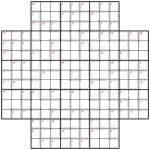Samurai Star Killer Sudoku

Samurai Star Killer (gentle) puzzle
“Star Killer” sounds like something out of science fiction, but it’s now definitely reality with this 5-grid Killer Sudoku puzzle. The actual Killer part uses the most basic logic imaginable, and there are a lot of ’singleton’ regions which I’ve never used in a Killer puzzle before. The reason for this is that I wanted to start at a gentle level – as a result this mostly solves like a regular Samurai Star (a.k.a. Flower Samurai) puzzle, with the Killer regions used occasionally to either get you going or help you out with a quick number along the way. It shouldn’t take you much over 20 or 30 minutes if you’ve solved this shape of Samurai before, and know what a Killer Sudoku is!
The rules are pretty simple: place 1 to 9 into each row, column and bold-lined 3×3 shape of each of the 5 underlying 9×9 grids (there’s one in the centre too), whilst also placing numbers so that the total in each dashed-line cage is equal to that given in the top-left corner. You may not repeat a number within a dashed-line cage.
The puzzle has rotation symmetry order 4, so the cages are in a pleasing pattern I hope – I particularly like the hole in the square in the centre! I think by and large that if you can create the cages or givens in a puzzle with the same order of symmetry that you have for the grid layout itself that this generally leads to a more pleasing appearance for the puzzle; but more than this, I find that this tends to follow through with the solving process, and you end up with pieces of the puzzle that feel ’sympathetic’ to one another, since the symmetry leads to related discoveries. However it’s perhaps not clear that this solving benefit carries through to a puzzle this large, and it’s probably the case that a puzzle with entirely random cages would feel just the same to actually solve at this size. But it wouldn’t look as nice!
Coming up in the following days I’m going to experiment in the space between Killer Sudoku and Ken Ken™ – in other words, using more operations than just addition, and possibly allowing repeated numbers in cages (although not on puzzles with 1-9 to place!). I already came across a puzzle called ‘Killer Sudoku Pro’ in the Saturday Telegraph newspaper (UK) – in this they keep the Killer Sudoku rules about not repeating digits in a cage, but specify different operations for cages (in actual fact the rules aren’t stated next to the puzzle in full, but I presume repeated digits are disallowed - it certainly solves okay with that assumption!). I haven’t seen anything precisely like that elsewhere and I thought it was actually quite fun (it wasn’t too hard!) so I’ll definitely try making some of those soon for sure. If you have any other ideas for how to mix these different types together feel free to post a comment!
Good luck!
Comments are closed.

about 14 years ago
I like this puzzle a lot, good variation for some variety. Although I may recommend just putting in the “givens”. It works just fine this way, but was kind of “tedious” to put in the given numbers myself. It’s more of a convenience issue than an issue with the actual puzzle. Though, placing them in myself made me feel like I had done much more than I actually had (A good confidence boost!).
about 14 years ago
Yes, I’m not very satisfied with having 1-cell cages – I think the best solution is just to get rid of them! I’ve never made Killer before with single-cell cages, but for these ‘new’ types I wanted to start nice and easy. But you’re right, it is satisfying to fill them in at the start! (I don’t know why, but it is!)
about 14 years ago
As the gentle ranking suggests, this was a doddle for me. I felt as if I couldn’t move my pencil fast enough filling in numbers. My favorite puzzles are killer sudokus and I look forward to the later ones you have made here.
One thing that made it easy was noting the 3-digit-set in the samurai star patterns. It saves a great deal of time knowing a 3-digit row/column in a region will be repeated in a region on the other side of the flower (in the same or different order). I am glad to add this to my solving arsenal for samurai star pattern.
As for killers, my preference is not to have givens or single cages. One of the zen things I like is starting with nothing and ending up with a full puzzle.
FYI: In the SF Show BABYLON 5, “Starkiller” is a derogatory nickname given to John Sheridan by the Minbari aliens for his part in the destruction of the Minbari flagship “Black Star” during the Earth-Minbari War.